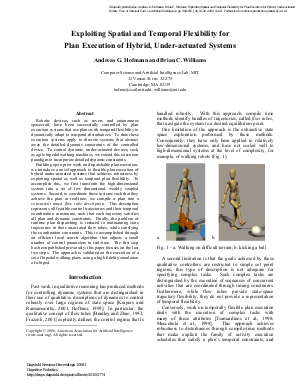Exploiting Spatial and Temporal Flexibility for Exploiting Spatial and Temporal Flexibility for Plan Execution of Hybrid, Under-actuated Systems
Authors Andreas G. Hofmann, Brian C. Williams
-
Part of:
Volume:
Dagstuhl Seminar Proceedings, Volume 10081
Part of: Series: Dagstuhl Seminar Proceedings (DagSemProc) - License:
 Creative Commons Attribution 4.0 International license
Creative Commons Attribution 4.0 International license
- Publication Date: 2010-10-27
File

PDF
DagSemProc.10081.8.pdf
- Filesize: 324 kB
- 8 pages
Document Identifiers
Metrics
- Access Statistics
-
Total Accesses (updated on a weekly basis)
0Document
0Metadata
Abstract
Robotic devices, such as rovers and autonomous spacecraft, have been successfully controlled by plan execution systems that use plans with temporal flexibility to dynamically adapt to temporal disturbances. To date these execution systems apply to discrete systems that abstract away the detailed dynamic constraints of the controlled device. To control dynamic, under-actuated devices, such as agile bipedal walking machines, we extend this execution paradigm to incorporate detailed dynamic constraints. Building upon prior work on dispatchable plan execution, we introduce a novel approach to flexible plan execution of hybrid under-actuated systems that achieves robustness by exploiting spatial as well as temporal plan flexibility. To accomplish this, we first transform the high-dimensional system into a set of low dimensional, weakly coupled systems. Second, to coordinate these systems such that they achieve the plan in real-time, we compile a plan into a concurrent timed flow tube description. This description represents all feasible control trajectories and their temporal coordination constraints, such that each trajectory satisfies all plan and dynamic constraints. Finally, the problem of runtime plan dispatching is reduced to maintaining state trajectories in their associated flow tubes, while satisfying the coordination constraints. This is accomplished through an efficient local search algorithm that adjusts a small number of control parameters in real-time. The first step has been published previously; this paper focuses on the last two steps. The approach is validated on the execution of a set of bipedal walking plans, using a high fidelity simulation of a biped.
Cite As Get BibTex
Andreas G. Hofmann and Brian C. Williams. Exploiting Spatial and Temporal Flexibility for Exploiting Spatial and Temporal Flexibility for Plan Execution of Hybrid, Under-actuated Systems. In Cognitive Robotics. Dagstuhl Seminar Proceedings, Volume 10081, pp. 1-8, Schloss Dagstuhl – Leibniz-Zentrum für Informatik (2010)
https://doi.org/10.4230/DagSemProc.10081.8
BibTex
@InProceedings{hofmann_et_al:DagSemProc.10081.8,
author = {Hofmann, Andreas G. and Williams, Brian C.},
title = {{Exploiting Spatial and Temporal Flexibility for Exploiting Spatial and Temporal Flexibility for Plan Execution of Hybrid, Under-actuated Systems}},
booktitle = {Cognitive Robotics},
pages = {1--8},
series = {Dagstuhl Seminar Proceedings (DagSemProc)},
ISSN = {1862-4405},
year = {2010},
volume = {10081},
editor = {Gerhard Lakemeyer and Hector J. Levesque and Fiora Pirri},
publisher = {Schloss Dagstuhl -- Leibniz-Zentrum f{\"u}r Informatik},
address = {Dagstuhl, Germany},
URL = {https://drops.dagstuhl.de/entities/document/10.4230/DagSemProc.10081.8},
URN = {urn:nbn:de:0030-drops-27740},
doi = {10.4230/DagSemProc.10081.8},
annote = {Keywords: }
}
